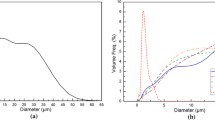Abstract
In this study, the carbon thermal reduction of agglomerate composed of pure silica and carbon was studied at 1898 K, 1923 K, and 1948 K. The main product of this reaction is silicon carbide. Compare the reduction effects of four types of coal from different industrial silicon enterprises on the analysis of pure silica, and explore the application of different coal in silicon production. C4 coal has high SiO reactivity, while C1 coal has low SiO reactivity. An increase in temperature will reduce the reaction matching degree of coal and increase the amount of SiO gas esca**. C4 coal has a high and stable reaction matching degree, and the reaction rate is less affected by temperature, making it the best coal among the four types to produce SiC.
Similar content being viewed by others
Data Availability
All of the material is owned by the authors and/or no permissions are required.
References
Schei A, Tuseth JK, Tveit H (1998) Production of High Silicon Alloys. Tapir Forlag, Trondheim
Raaness O, Gray R (1995) Coal in the production of silicon rich alloys. INFACON 7. Trondheim, Norway, p 201
Hasannezhad H, Meysami A (2021) Comparison of biomass and coal in the recovery process of silicon in an electric arc furnace. JOM. https://doi.org/10.1007/s11837-020-04533-6
Tangstad M, Beukes JP, Steenkamp J, Ringdalen E (2019) Coal-based reducing agents in ferroalloys and silicon production. Combustion, Gasification, Emissions, and Coking 2019:405. https://doi.org/10.1016/B978-0-08-102201-6.00014-5
Duan XJ (2021) Discussion on industrial grade silicon smelting process with all-coal in large capacity submerged arc furnace. Ferro-Alloys. https://doi.org/10.16122/j.cnki.issn1001-1943.2021.02.001
Myrvgnes V, Lindstad T (2007) The importance of coal- and coke properties in the production of high silicon alloys. INFACON XI. New Delhi, India, pp 402
Buø TV, Gray RJ, Patalsky RM (2000) Reactivity and petrography of cokes for ferrosilicon and silicon production. Int J Coal Geol. https://doi.org/10.1016/S0166-5162(99)00062-2
Mekhtiev AD, Tolymbekov MJ, Kim AV, Zholdubaeva ZhD, Issin DK, Issagulov AZ, Issin BD (2014) Silicon production using long flaming coal and improvement of its quality indicators. METALURGIJA 53:563
Strakhov VM, Surovtseva IV, Elkin DK, Elkin KS, Cherevko AE (2012) Using SS coal in silicon production. Coke Chem. https://doi.org/10.3103/S1068364X1202007X
Li F (2017) SiC production using SiO2 and C agglomerates. Ph.D. thesis, Norwegian University of Science and Technology
GB/T 212-2008 (2008) Proximate analysis of coal. Standards Press of China, China
Cheng B, Ma DH, Gao Y (2017) Correlation of ash content,volatile matter and porosity of coal and their impact on initial speed of methane diffusion. Min Saf Environ Prot. https://doi.org/10.3969/j.issn.1008-4495.2017.01.004
GB/T 5751-2009 (2009) Chinese classification of coals. Standards Press of China, China
Meng QY, Yang Zh R, Huang JJ, Wang ZhQ, Li ChY, Fang YT (2017) Caking property of shenmu coal and caking coal blending coals for coke-making. Coal Convers. https://doi.org/10.19726/j.cnki.ebcc.2017.05.008
Li F, Tangstad M (2018) Carbothermal reduction of quartz and carbon pellets at elevated temperatures. Metall Mater Trans. https://doi.org/10.1007/s11663-018-1195-x
Sun TM, Dong LM, Wang Ch, Guo WL, Wang L, Liang TX (2013) Effect of porosity on the electrical resistivity of carbon materials. New Carbon Mater. https://doi.org/10.1016/S1872-5805(13)60087-6
Acknowledgements
This work was supported by the [National Science Foundation of China #1] under Grant [number 51904140]; [National Science Foundation of Gansu province China #2] under Grant [number 20JR10RA176]; and [Hongliu Outstanding Young Talent Support Program from Lanzhou University of Technology #3]. We are very grateful for this.
Funding
This work was supported by the [Gansu Province Science and Technology Program #1] under Grant [number 23ZDGD002]; [Lanzhou Youth Science and Technology Talent Innovation Project #2] under Grant [number 2023-QN-94] and [National Science Foundation of China #3] under Grant [number 51904140].
Author information
Authors and Affiliations
Contributions
[Fei Li] contributed to the study conception and design. Material preparation, data collection and analysis were performed by [Kaixin Yang], [Fei Li], [Wangwang Fu] and [Dahui Wang]. The first draft of the manuscript was written by [Fei Li] and [Kaixin Yang] and all authors commented on previous versions of the manuscript. All authors read and approved the final manuscript.
Corresponding author
Ethics declarations
Ethics Approval
Not applicable: Authors declare no research involving human participants and/or animals was conducted.
Consent to Participate
All the authors are voluntarily participating in the submission of this research work.
Consent for Publication
The authors confirm that this manuscript has not been submitted or published previously to any other journal and give full consent for publication of this research work.
Competing Interests
The authors declare no competing interests.
Additional information
Publisher's Note
Springer Nature remains neutral with regard to jurisdictional claims in published maps and institutional affiliations.
Rights and permissions
Springer Nature or its licensor (e.g. a society or other partner) holds exclusive rights to this article under a publishing agreement with the author(s) or other rightsholder(s); author self-archiving of the accepted manuscript version of this article is solely governed by the terms of such publishing agreement and applicable law.
About this article
Cite this article
Li, F., Yang, K., Fu, W. et al. Carbothermal Reduction of SiO2 Using Different Coal. Silicon 16, 1967–1976 (2024). https://doi.org/10.1007/s12633-023-02807-7
Received:
Accepted:
Published:
Issue Date:
DOI: https://doi.org/10.1007/s12633-023-02807-7




